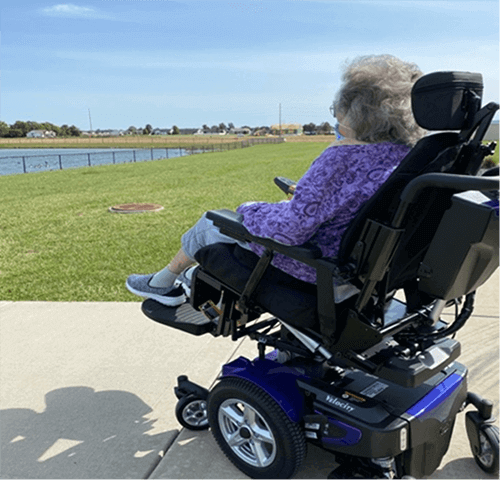Table of contents
Beverly, age 85, has been living in a senior living community in Bethalto, IL for two years. She often has trouble maintaining balance when reaching, and recently experienced a fall when trying to reach for something behind a cabinet next to her recliner in her room. She fell between the cabinet and her dining room table, resulting in vertebral fractures. After her fall she experienced a progressive decline and increased caregiver dependence. Her daughter moved into the community with her to provide extra support, but this was a short-term plan.
In addition to the difficulty with her vertebral fractures, Beverly suffers from a condition called polymyalgia rheumatica, which causes inflammation, stiffness, and pain in her joints and muscles. She also developed pressure sores, increased pain, and further limitations in her shoulder range of motion, making it difficult for her to reach overhead. She experienced discomfort with prolonged sitting due to poor postural alignment in her upper body.
With these combined challenges, Beverly could only walk short distances using a rollator. She primarily used a manual wheelchair in her room and a standard power chair for mobility within the community.
More than just physically, Beverly’s health concerns also impacted how she could interact socially in her community. She hesitated to participate in community activities for fear of falling or further complications. At this stage in her health journey, she was fully dependent on caretakers and family to help navigate her room and perform daily activities.
After her fall, Beverly began therapy services with EmpowerMe therapists located in her community. The goal was to regain her physical confidence and expand her mobility. Her therapy team began her program by first establishing a sense of trust and rapport. Building a supportive relationship would be the motivational foundation for Beverly’s recovery efforts. They formulated a plan for physical therapy to improve her range of motion, strength, and flexibility, combined with suggestions for adaptive equipment that would safely improve her ability to navigate through her room and the community.
Beverly soon began to see the success of her therapy. In addition to increasing her range of motion, EmpowerMe therapists took the time to educate her on the benefits of adaptive equipment. They worked diligently to find equipment that would be covered by her insurance. This equipment was necessary to expand Beverly’s ability to navigate her room, reach for necessary objects, and engage further in the community.
Beverly was quickly evaluated for a new power wheelchair during an occupational therapy visit. She qualified for a custom cushion on her seat, a tilt feature to complete pressure relief throughout the day, and a 0-turning radius that allowed her to navigate her apartment versus using her manual wheelchair. Beverly also chose to purchase an elevating feature on her new chair which allows her to raise up about two feet.
Initially, she was overwhelmed with the number of buttons and options on the power wheelchair, but with the therapist’s help, and the use of visual aid development, she is now able to use the basic features (power switch, maneuvering the joystick, parking, and swiveling joystick paddle out of the way). She is also able to use the advanced features that allow her to tilt, recline, and elevate to allow for improved positioning.
These features in addition to occupational therapies have allowed Beverly to:
- Reach light switches on her wall
- Reach her thermostat
- Manage her clothing when using the bathroom for greater than 75% of the time (compared to full assistance needed previously)
- Better position herself at the tables in the dining room
- Transfer from her recliner to her power wheelchair with stand-by assist or modified independence, utilizing a rollator in a new parking spot
- Increase her sitting tolerance which allows her to go to the community theater for weekly movies
- Increase her safety when going down to the community lake dock by tilting her chair backward when going down the ramp
- And, importantly, decrease her risk for falls, allowing her to confidently engage in social activities
She is also now able to easily open her apartment door to take her chihuahua on ‘walks’ throughout the community. Opening the door was a struggle previously due to limited range of motion in her upper body, but therapists helped her find a solution to let her dog pass through that required less arm strength and a simpler range of motion.
Beverly is now able to experience a level of independence beyond family and caretaker support. She has begun to prefer company rather than being alone. She also recently told a therapist she has been using her power chair on her own in the evenings to ‘take a walk’ around the outdoor courtyard and parking lot of the community.
At first, Beverly showed resistance to her therapy team’s recommendations, but over time, she grew to trust their suggestions and has experienced amazing progress as a result!
Beverly was quoted telling one of her therapists: “You know, we were just talking about you last night and my daughter said that if our family was stuck on a deserted island, we would hope you’d be there with us because you would definitely figure a way out.”
Over the course of 12 weeks, therapy has become a source of joy for Beverly, helping her experience life as vibrantly and as socially possible within her community. She can now navigate her home with increased confidence and has regained independence in her daily routine.



